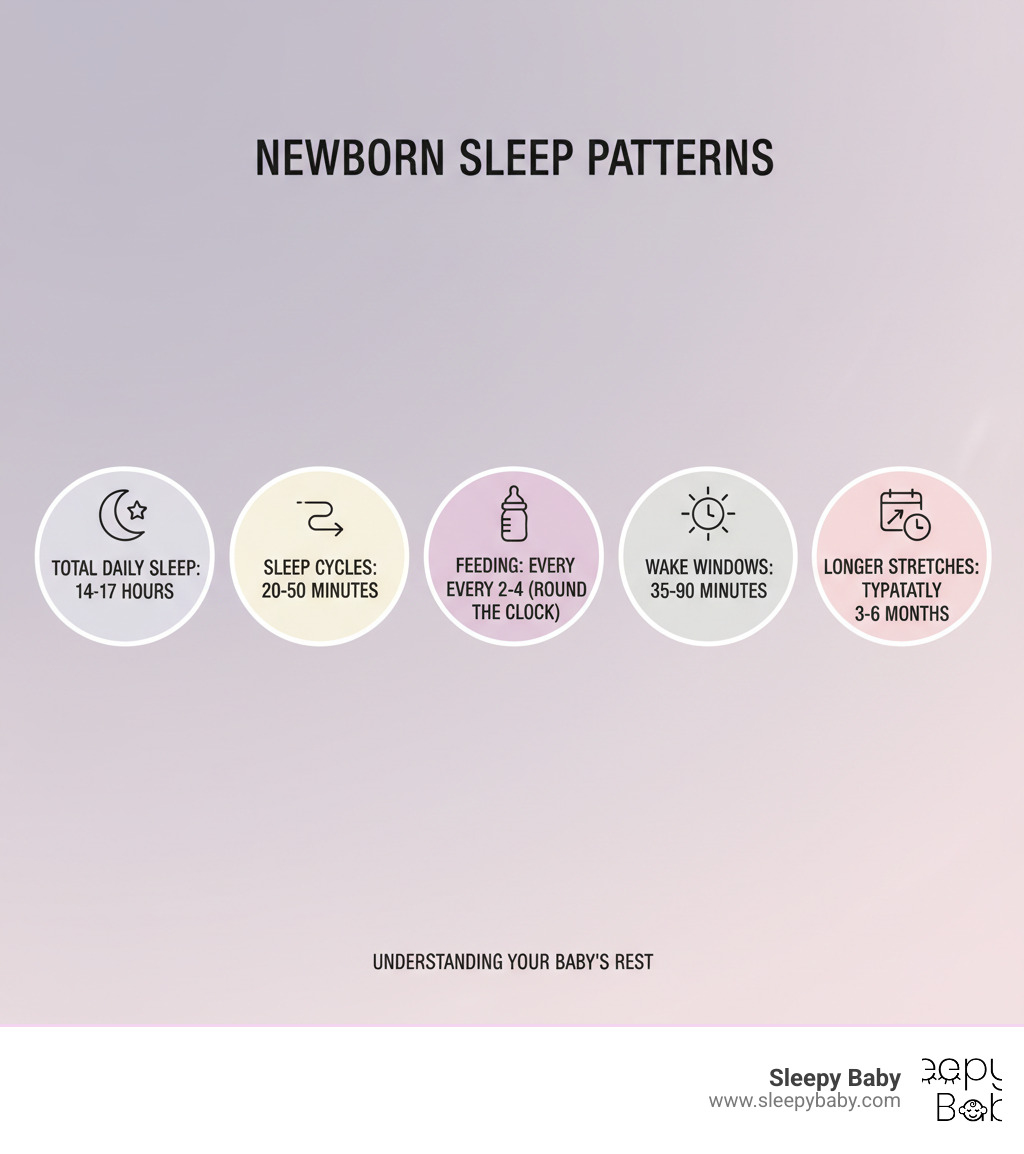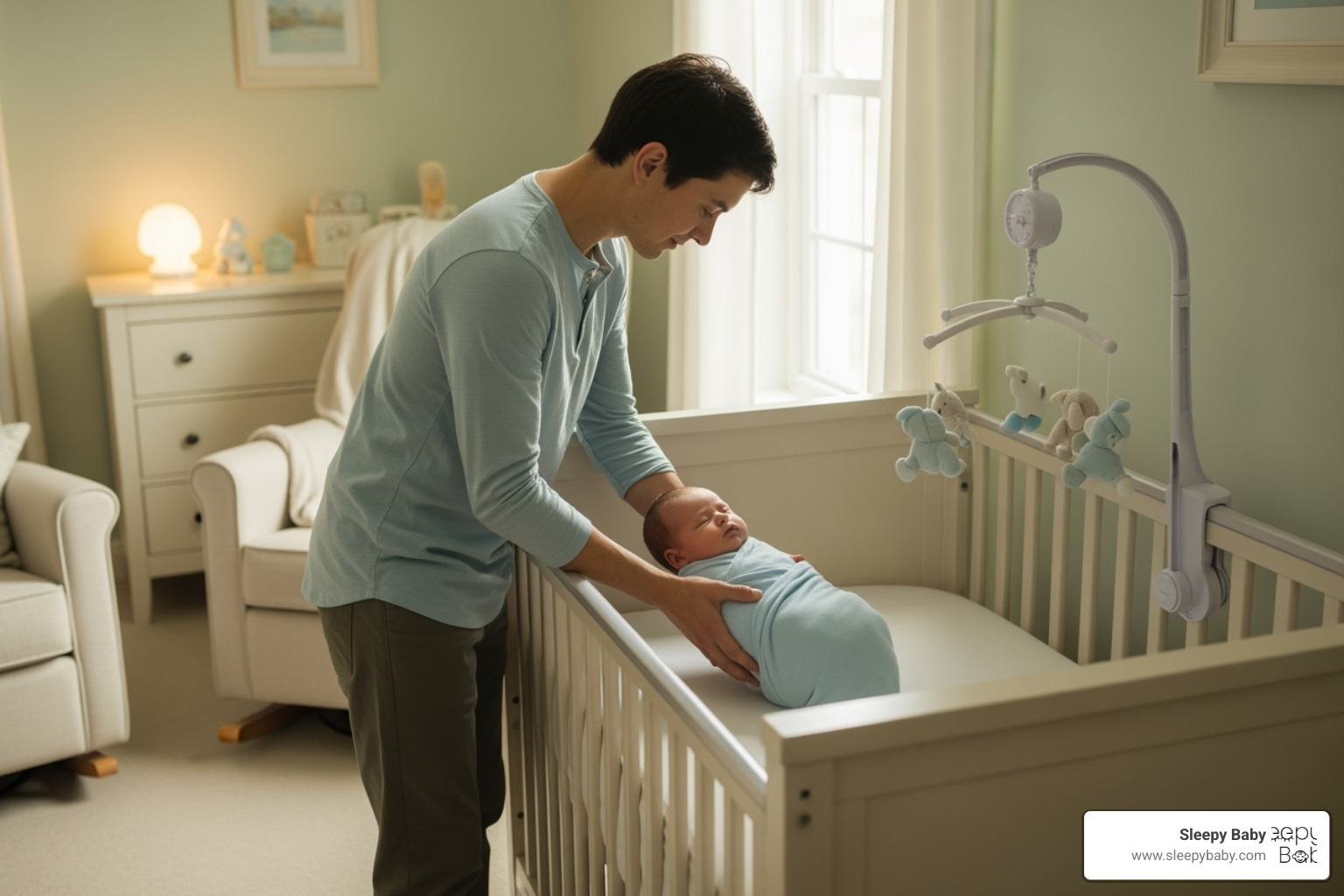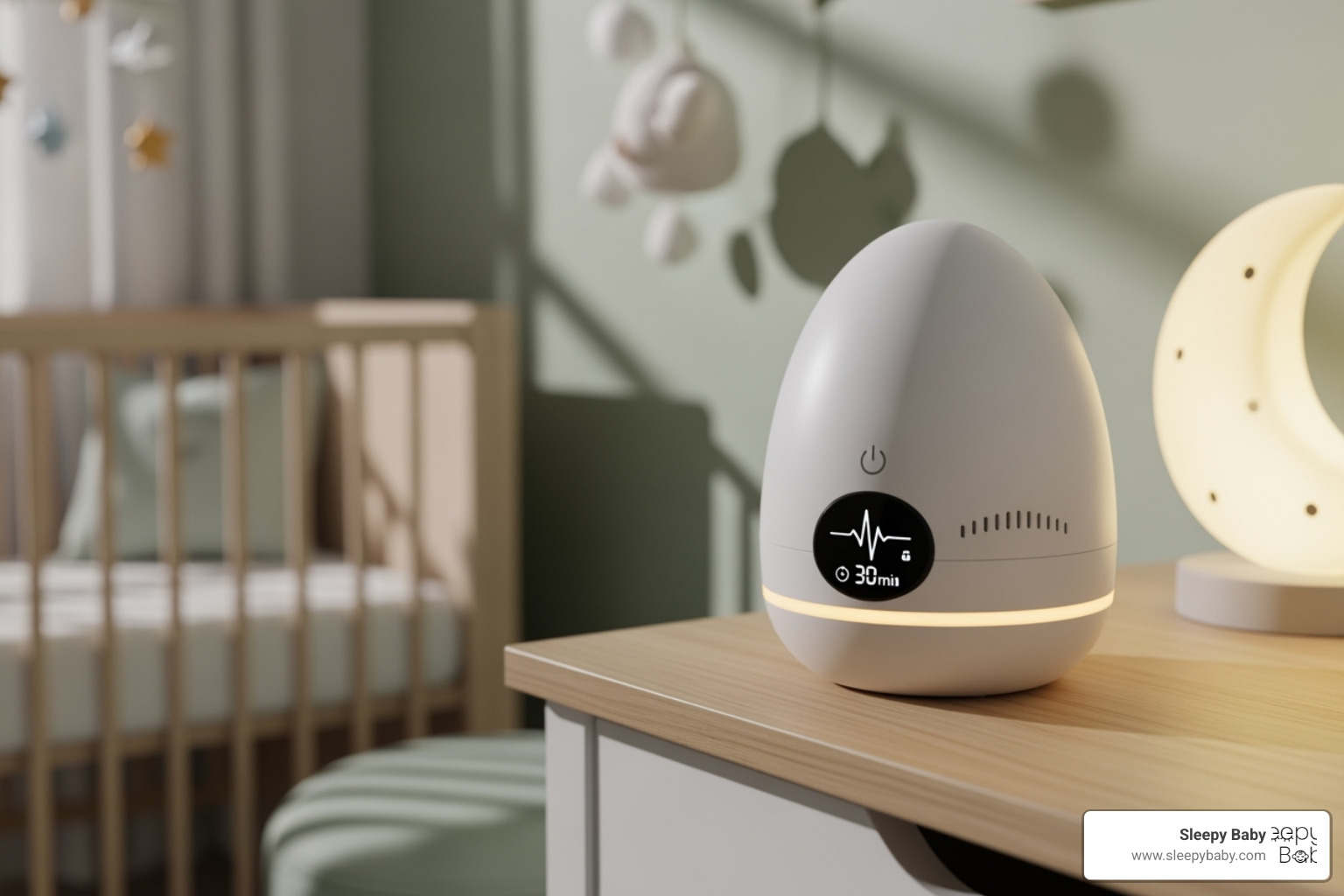Why Understanding Newborn Sleep Patterns Is Crucial for New Parents
Newborn sleeping can feel like a mystery. Your baby sleeps most of the day, yet you're exhausted from constant wake-ups. This is completely normal, even if it feels chaotic.
Quick Answer for Tired Parents:
- Total Sleep: Newborns need 14-17 hours daily
- Sleep Chunks: They sleep in 2-3 hour periods, not long stretches
- Wake Windows: Only awake 45-90 minutes before needing sleep again
- Night Feeds: Expect waking every 2-4 hours for feeding
- Timeline: Most babies sleep longer stretches around 3-6 months
Newborns sleep in short bursts because their tiny stomachs need frequent refilling and their internal clock hasn't developed. Understanding these patterns is the first step toward better sleep for your whole family. When you know what to expect, you can work with your baby's natural rhythms, create realistic expectations, and build routines that actually work. Most importantly, it reassures you that frequent wake-ups are temporary.
I'm Gary Harutyunyan, a new father who struggled with newborn sleeping challenges. My experience led me to research and develop solutions that help families get the rest they need through safe, effective sleep aids.

Newborn sleeping further reading:
The Science of Newborn Sleep: Why They Sleep So Much (and So Little)
Here's the contradiction of newborn sleeping: your baby sleeps 14-17 hours a day, yet you feel like you haven't slept in weeks. This is because newborn sleep is fragmented, broken into 20-50 minute sleep cycles with wake-ups every 2-4 hours. This is by design.
Newborn sleep cycles are short. They spend about half their sleep in "active sleep" (similar to REM), where you might see them twitching, making sounds, or breathing irregularly. They are still asleep. The other half is "quiet sleep," where they lie still with even breathing.
This sleep is crucial for development. Research shows a strong link between infant sleep and its relation with cognition and growth. Sleep is literally building your baby's brain and supporting physical growth.
Day-night confusion is also normal. Your baby's internal clock, or circadian rhythm, won't start developing until around 8-9 weeks. Until then, their days and nights will be mixed up as they adjust to life outside the womb.
How Feeding Schedules Impact Sleep
Your newborn's tiny stomach is the main reason for frequent wake-ups. At birth, it's the size of a marble. Small stomachs mean frequent feedings, which means fragmented sleep.
- Breastfed babies often eat every 2-3 hours.
- Bottle-fed babies might stretch to 3-4 hours.
This means you'll likely need to wake your baby to feed in the early weeks to ensure proper weight gain. While it feels wrong to disturb a sleeping baby, it's essential for their health. For more on this, see Should I Wake My Newborn to Feed or Let Sleeping Babies Lie?.
Cluster feeding, where your baby feeds frequently over several hours (often in the evening), is also common and can sometimes lead to a longer stretch of sleep afterward.
Understanding Your Newborn's Alert Phases
Between sleeping and eating, your newborn has distinct alert phases that signal their needs.
- Quiet Alert: Your baby is calm, awake, and taking in the world. This is the perfect time for gentle interaction and bonding.
- Active Alert: Your baby is moving, making sounds, and more engaged. This is still good for interaction, but watch for signs of overstimulation.
- Crying: This is a late cue that your baby is hungry, uncomfortable, or overtired. An upset baby can be difficult to soothe.
Recognizing overstimulation (looking away, arching back, fussiness) is key to preventing meltdowns. When you see these signs, it's time to wind down for sleep. Understanding these phases helps you work with your baby's natural rhythms, interacting during alert times and promoting sleep before they become overtired.
Creating a Safe Sleep Sanctuary for Your Newborn
Creating a safe sleep environment is about protecting your baby's life. When it comes to newborn sleeping, safety is everything. The good news is that the guidelines are straightforward.

The foundation of safe sleep is the ABCs: Alone, on their Back, in a Crib. These rules, backed by the American Academy of Pediatrics official safe-sleep guidelines, have dramatically reduced SIDS rates.
- Back to sleep: Always place your baby on their back for every sleep, naps included. If they can roll over on their own, you can let them find their own position, but always start them on their back.
- Firm, flat surface: Use a firm mattress in a safety-approved crib, bassinet, or play yard with only a snug-fitting sheet.
- Bare is best: Keep the sleep space free of bumpers, blankets, pillows, and toys. Your baby needs safety, not soft comfort items in their crib.
Keep the room temperature between 68-72°F (20-22°C) to prevent overheating. A sleep sack is a safe alternative to blankets.
Room-Sharing vs. Bed-Sharing
The AAP strongly recommends room-sharing without bed-sharing for at least the first six months. This means your baby sleeps in your room but on a separate, safe surface like a crib or bassinet. This practice can reduce SIDS risk by up to 50% and makes nighttime feedings easier.
Bed-sharing carries significant risks. Adult beds, soft mattresses, and bedding create suffocation hazards. The risk increases if a parent smokes, has consumed alcohol, or is taking certain medications. While the convenience is tempting, a separate, safe sleep surface is always the safest choice. For help choosing, see our article From Cradle to Bassinet: Ensuring Sweet Dreams for Your Newborn.
A Parent's Guide to Better Newborn Sleeping Habits
While newborn sleeping can feel chaotic, a few key strategies can help your baby develop healthier sleep habits and make the early weeks smoother.

Help your newborn learn the difference between day and night. During the day, accept natural light and normal household sounds. Engage with your baby during their alert moments. In the evening, dim the lights, lower your voice, and keep interactions calm. This contrast helps set their internal clock.
While newborns can't follow a strict schedule, a flexible routine creates a predictable flow. The sequence of eat, play, sleep is more important than the timing. Our guide, Routine Magic: Creating a Newborn Schedule for Success, explains how to build this rhythm while responding to your baby's cues.
Decoding Your Baby's Sleep Cues and Wake Windows
Learning your baby's sleepy cues is a superpower. Responding to early signals helps them settle more easily. Watch for yawning, eye/ear rubbing, fussing, or staring into space. Crying is a late sign of overtiredness, making it much harder to settle your baby.
Also, respect their wake windows—the short time they can stay awake between naps. For newborns (0-12 weeks), this is typically just 35-90 minutes. Keeping awake time short prevents an overtired state, which ironically leads to worse sleep.
Establishing a Soothing Bedtime Routine for newborn sleeping
Starting a gentle bedtime routine around 8-12 weeks can be very effective. Research on the Benefits of a bedtime routine in young children shows it improves sleep. A simple, consistent routine is best. Try a sequence like a warm bath, fresh pajamas, a quiet feeding, and a soft lullaby. The consistency signals to your baby's brain that it's time to sleep. For more ideas, see our Guide to the Best Baby Bedtime Ritual.
Try to sometimes put your baby down when they are drowsy but still awake. This helps them learn to fall asleep independently.
The Role of Swaddling and Other Soothing Techniques
Swaddling can be a game-changer for newborn sleeping. It recreates the cozy feeling of the womb and helps control the Moro (startle) reflex that can wake babies up. Always use proper swaddling techniques that are loose around the hips, as reviewed by sources like The Lullaby Trust.
Crucially, you must stop swaddling as soon as your baby shows signs of rolling over (usually 2-4 months). A swaddled baby who rolls onto their stomach is at serious risk. Transition to a sleep sack at this point.
Other soothing techniques include offering a pacifier, gentle rocking, shushing sounds, and white noise, which can block out household sounds. Modern, safety-rated sleep aids can also be effective tools.
Common Challenges and Milestones in Your Baby's Sleep Journey
The first few months with a newborn often feel like a sleep-deprived fog. The exhaustion from newborn sleeping patterns is a universal part of new parenthood, and it's normal to feel overwhelmed.
The advice to "sleep when the baby sleeps" is genuinely helpful, even if it's just for a 20-minute nap. Don't hesitate to ask for help from a partner, family, or friends to share nighttime duties. Taking care of yourself is essential. For more strategies, see our guide on Tackling Newborn Sleep Disturbances.
Your baby's sleep will evolve. Around 8-9 weeks, their circadian rhythm begins to develop. By 3-4 months, many babies start learning to self-settle, though this varies greatly.
Understanding Common Challenges with newborn sleeping
Babies are surprisingly noisy sleepers. Grunting, gurgling, and whistling are all normal sounds caused by their maturing respiratory system and tiny nasal passages. Their breathing can also be irregular, with quick breaths followed by brief pauses.
When to be concerned: While most noises are harmless, seek immediate medical attention for warning signs of respiratory distress. According to resources like Seattle Children's Hospital, these include rapid breathing (over 70 breaths/minute), persistent grunting with each breath, flaring nostrils, or retractions (skin pulling in at the ribs or neck).
Another common challenge is the "period of PURPLE crying," which can peak around 6-8 weeks and involves long bouts of crying for no apparent reason. This is a normal developmental phase that will pass.
When to Expect Longer Stretches of Sleep
The question every parent asks is, "When will my baby sleep through the night?" For an infant, "sleeping through the night" usually means a 5-6 hour stretch, not 8-10 hours.
Most babies reach this milestone between 4-6 months, but some may not until closer to their first birthday. There is a wide range of normal, influenced by temperament, growth spurts, and feeding method. Breastfed babies may take longer to reach this milestone.
Consult your pediatrician if you have persistent concerns, notice sudden changes in sleep, or if sleep issues are paired with other symptoms like poor feeding or excessive fussiness.
The Role of Modern Sleep Aids in Newborn Sleeping
When you're exhausted and your baby won't settle, modern sleep aids can be a huge help. While nothing replaces your touch, the right tools can support you through challenging newborn sleeping phases.

White noise is a popular tool because it mimics the womb and can mask startling household sounds. It's crucial to choose safety-rated devices that operate at low, safe decibel levels. While some traditional machines can be too loud, modern aids are designed with your baby's sensitive hearing in mind. Some innovative devices even deliver targeted, chest-based sound for a more intimate, womb-like experience.
Rhythmic tapping devices are another breakthrough. These intelligent sleep aids mimic the gentle, rhythmic patting that parents use to soothe their babies, recreating that comforting sensation when your arms need a break.
At Sleepy Baby, our portable sleep aids combine rhythmic patting and white noise. This hands-free soothing approach provides the consistent comfort your baby craves, with customizable settings to find what works best for your little one. These tools are meant to complement responsive parenting, helping your baby associate certain sensations with sleep and fostering better rest for the whole family.
For a closer look at effective sleep aids, check out our guide: Best Sleep Aid for Newborns That Actually Work So You Can Sleep Too.
Frequently Asked Questions about Newborn Sleep
Let's tackle some of the most common questions parents have about newborn sleeping.
How much sleep do newborns really need?
Newborns need 14-17 hours of sleep in a 24-hour period. However, this sleep comes in short bursts of 2-3 hours at a time, around the clock. This fragmented pattern is due to their tiny stomachs, which need frequent refilling. It's biologically normal and will consolidate into longer stretches as they grow.
Is it safe to let my newborn sleep in a swing or car seat?
No, it is not safe for routine sleep. The American Academy of Pediatrics advises that the safest place for a baby to sleep is on a firm, flat surface, on their back, in a safety-approved crib, bassinet, or play yard. Sleeping in an inclined position in a swing or car seat can cause their head to slump forward, obstructing their airway (positional asphyxiation). If your baby falls asleep in a car seat or swing, move them to a safe sleep space as soon as possible.
When can I start sleep training my baby?
Formal sleep training is not recommended for newborns. Their cries are a form of communication for basic needs like hunger or comfort, and their brains are not yet ready to learn self-soothing skills. Most experts recommend waiting until your baby is at least 4-6 months old before considering any formal sleep training methods. Until then, focus on establishing gentle routines, learning sleep cues, and creating a safe, consistent sleep environment.
Conclusion
Navigating newborn sleeping is a journey. If you're reading this in the middle of the night, know that you're not alone. Your baby's fragmented sleep is a normal, temporary phase designed for their rapid growth.
Remember these key takeaways:
- Safety is paramount. Always follow the ABCs of Safe Sleep: Alone, on their Back, in a Crib.
- Routines and cues are your tools. A flexible routine and learning your baby's sleepy cues can make a world of difference.
- This is normal. Frequent wake-ups, noisy sleeping, and day-night confusion are all part of the newborn phase. It will pass.
It's okay to feel exhausted and to ask for help. Modern sleep aids can also offer support. While nothing replaces you, safety-rated devices that provide gentle white noise or rhythmic patting can be valuable allies, complementing your responsive care.
Your patience and love during this newborn sleeping phase are laying the foundation for a lifetime of healthy sleep. At Sleepy Baby, we understand these challenges and are here to support you.
For more insights and resources to help your family thrive, explore more on our blog. Sweet dreams are coming.




